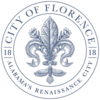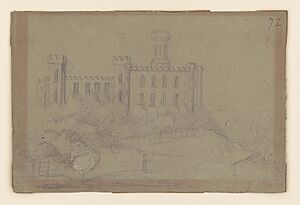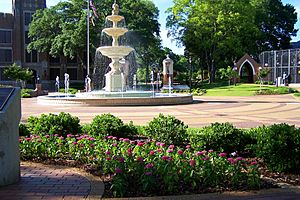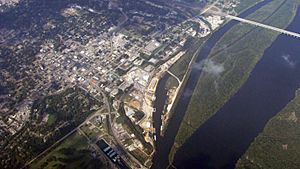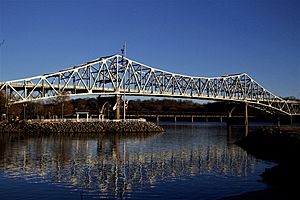Florence, Alabama facts for kids
Quick facts for kids
Florence, Alabama
|
|||
|---|---|---|---|
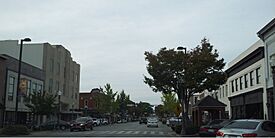
Downtown Florence Historic District
|
|||
|
|||
| Nickname(s):
"Alabama's Renaissance City"
|
|||
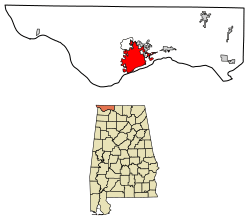
Location of Florence, Alabama
|
|||
| Country | United States | ||
| State | Alabama | ||
| County | Lauderdale | ||
| Founded | March 12, 1818 | ||
| Incorporated | January 7, 1826 | ||
| Named for | Florence, Tuscany, Italy | ||
| Government | |||
| • Type | Mayor–Council (Since 1984) | ||
| Area | |||
| • City | 27.293 sq mi (70.689 km2) | ||
| • Land | 27.084 sq mi (70.147 km2) | ||
| • Water | 0.209 sq mi (0.541 km2) | ||
| Elevation | 604 ft (184 m) | ||
| Population
(2020)
|
|||
| • City | 40,184 | ||
| • Estimate
(2023)
|
42,437 | ||
| • Rank | US: 954th AL: 11th |
||
| • Density | 1,596.99/sq mi (616.61/km2) | ||
| • Urban | 78,925 (US: 360th) | ||
| • Metro | 155,175 (US: 280th) | ||
| Time zone | UTC−6 (Central (CST)) | ||
| • Summer (DST) | UTC−5 (CDT) | ||
| ZIP Codes |
35630, 35631, 35632, 35633, 35634
|
||
| Area code(s) | 256 and 938 | ||
| FIPS code | 01-26896 | ||
| GNIS feature ID | 2403619 | ||
| Sales tax | 9.5% | ||
Florence is a city in northwestern Alabama, United States. It's the main city of Lauderdale County. In 2020, about 40,184 people lived here.
Florence is right by the Tennessee River. It's also home to the University of North Alabama, which is the oldest public college in Alabama. The city is about 70 miles west of Huntsville, Alabama and 115 miles northwest of Birmingham, Alabama.
Florence is the biggest city in an area called "The Shoals." This area also includes the cities of Muscle Shoals, Sheffield, and Tuscumbia. Together, The Shoals had a population of 148,779 in 2020. Florence is a major center for business and jobs in northwestern Alabama.
Every year, Florence hosts fun events like the W. C. Handy Music Festival in the summer and the Renaissance Faire in the fall. You can also visit famous places like the Rosenbaum House, which is the only home in Alabama designed by the famous architect Frank Lloyd Wright. The Florence Indian Mound is another important spot. It's a large earth mound built by Native Americans long ago, between 400 BCE and 100 BCE. It's the biggest one left in Alabama.
Contents
- Exploring Florence: Geography and Climate
- Florence Through Time: A Brief History
- Who Lives in Florence? Demographics
- Learning in Florence: Education
- Fun in Florence: Culture and Events
- Outdoor Adventures: Recreation
- Getting Around: Transportation
- News and Entertainment: Media
- Famous Faces: Notable People from Florence
- See also
Exploring Florence: Geography and Climate
Florence is located at 34°49′49.26″N 87°39′55.51″W / 34.8303500°N 87.6654194°W.
How Big is Florence?
The city covers about 27.29 square miles (70.68 square kilometers). Most of this area is land, with a small part being water.
Rivers and Lakes in Florence
Florence is located on Wilson Lake and Pickwick Lake. These are parts of the Tennessee River. They were created by dams called Pickwick Dam and Wilson Dam. The Tennessee Valley Authority (TVA) built Pickwick Lake as part of a big project. This project aimed to create electricity, control floods, and offer fun activities in the area. Wilson Dam was the first dam built on the Tennessee River, starting in 1918.
What's the Weather Like in Florence?
Florence has a humid subtropical climate. This means it has hot, humid summers and generally mild to cool winters. The average temperature in Florence is about 59°F (15°C). The city gets about 57 inches (145 cm) of rain each year. It also gets a small amount of snow, about 2.25 inches (5.7 cm) per year.
Even though Florence is far from the Gulf of Mexico, strong hurricanes can sometimes bring bad weather. For example, in 2005, Hurricane Katrina caused winds of almost 70 mph (110 km/h) and some damage.
| Climate data for Florence, 1991–2020 simulated normals (558 ft elevation) | |||||||||||||
|---|---|---|---|---|---|---|---|---|---|---|---|---|---|
| Month | Jan | Feb | Mar | Apr | May | Jun | Jul | Aug | Sep | Oct | Nov | Dec | Year |
| Mean daily maximum °F (°C) | 50.5 (10.3) |
55.0 (12.8) |
63.7 (17.6) |
72.7 (22.6) |
80.1 (26.7) |
87.1 (30.6) |
89.8 (32.1) |
89.4 (31.9) |
84.6 (29.2) |
74.3 (23.5) |
62.4 (16.9) |
53.4 (11.9) |
71.9 (22.2) |
| Daily mean °F (°C) | 40.6 (4.8) |
44.2 (6.8) |
52.2 (11.2) |
60.6 (15.9) |
69.1 (20.6) |
76.5 (24.7) |
79.5 (26.4) |
78.6 (25.9) |
73.0 (22.8) |
61.9 (16.6) |
50.5 (10.3) |
43.5 (6.4) |
60.9 (16.0) |
| Mean daily minimum °F (°C) | 30.7 (−0.7) |
33.6 (0.9) |
40.5 (4.7) |
48.7 (9.3) |
58.1 (14.5) |
65.8 (18.8) |
69.3 (20.7) |
68.0 (20.0) |
61.3 (16.3) |
49.3 (9.6) |
38.7 (3.7) |
33.4 (0.8) |
49.8 (9.9) |
| Average precipitation inches (mm) | 5.30 (134.60) |
5.28 (134.01) |
5.44 (138.15) |
5.20 (132.00) |
4.92 (124.98) |
4.84 (122.88) |
4.96 (125.97) |
4.22 (107.26) |
4.08 (103.70) |
3.63 (92.17) |
4.12 (104.57) |
6.07 (154.24) |
58.06 (1,474.53) |
| Average dew point °F (°C) | 32.2 (0.1) |
34.7 (1.5) |
40.5 (4.7) |
48.7 (9.3) |
58.5 (14.7) |
66.4 (19.1) |
70.0 (21.1) |
68.7 (20.4) |
62.8 (17.1) |
51.8 (11.0) |
41.0 (5.0) |
35.8 (2.1) |
50.9 (10.5) |
| Source: PRISM Climate Group | |||||||||||||
Florence Through Time: A Brief History
Early Days and Founding
People have lived in the Florence area for a very long time. The Florence Indian Mound, the largest of its kind in the Tennessee Valley, was built around 500 BCE. Later, the Chickasaw Nation lived here. In the early 1800s, they had to give up their land to the U.S. government.
In 1818, a group of people, including General John Coffee, decided to create a town on a hill overlooking the Tennessee River. They thought this spot would be great for trade. In 1819, an Italian engineer named Ferdinand Sannoner planned the town. He named it after Florence, a beautiful city in Italy.
Growing as a River Town (1826–1860)
Florence quickly became an important trading center on the Tennessee River. The first steamboat visited in 1821. The town officially became a city in 1826.
People started growing a lot of cotton nearby. This meant better ways to transport goods were needed. A canal was built around the Muscle Shoals in 1837, but it didn't work well for steamboats. Railroad bridges were also built across the Tennessee River to help with trade.
Many factories opened in Florence, making things like iron, lumber, cotton, and wool. Large farms called plantations also grew around Florence. These farms grew cotton and used enslaved people to do the work.
Florence also became a place for education. The Florence Female Academy opened in 1847 for girls. Later, LaGrange College, Alabama's first college, moved to Florence in 1855. It was renamed Florence Wesleyan University. Today, this university is known as the University of North Alabama.
The 20th Century in Florence
The Burrell Normal School was open from 1903 to 1969. It was a private school for African American students in Florence. It also trained teachers.
Who Lives in Florence? Demographics
| Historical population | |||
|---|---|---|---|
| Census | Pop. | %± | |
| 1850 | 802 | — | |
| 1860 | 1,395 | 73.9% | |
| 1870 | 2,003 | 43.6% | |
| 1880 | 1,359 | −32.2% | |
| 1890 | 6,012 | 342.4% | |
| 1900 | 6,478 | 7.8% | |
| 1910 | 6,689 | 3.3% | |
| 1920 | 10,529 | 57.4% | |
| 1930 | 11,729 | 11.4% | |
| 1940 | 15,043 | 28.3% | |
| 1950 | 23,879 | 58.7% | |
| 1960 | 31,649 | 32.5% | |
| 1970 | 34,031 | 7.5% | |
| 1980 | 37,029 | 8.8% | |
| 1990 | 36,426 | −1.6% | |
| 2000 | 36,264 | −0.4% | |
| 2010 | 39,319 | 8.4% | |
| 2020 | 40,184 | 2.2% | |
| 2023 (est.) | 42,437 | 7.9% | |
| U.S. Decennial Census 2020 Census |
|||
In 2023, there were about 17,203 homes in Florence. Each home had about 2.25 people. The average household income was $50,396. About 19.3% of the people in the city lived below the poverty line.
Most people in Florence have a high school diploma (90.8%). About 31.1% have a college degree or higher. The average age in the city was 35.1 years old.
Florence's Population in 2020
| Race / ethnicity (NH = non-Hispanic) | Pop. 2000 | Pop. 2010 | Pop. 2020 | % 2000 | % 2010 | % 2020 |
|---|---|---|---|---|---|---|
| White alone (NH) | 28,184 | 28,986 | 28,006 | 77.72% | 73.72% | 69.69% |
| Black or African American alone (NH) | 6,932 | 7,573 | 7,503 | 19.12% | 19.26% | 18.67% |
| Native American or Alaska Native alone (NH) | 84 | 146 | 122 | 0.23% | 0.37% | 0.30% |
| Asian alone (NH) | 224 | 537 | 519 | 0.62% | 1.37% | 1.29% |
| Pacific Islander alone (NH) | 8 | 16 | 22 | 0.02% | 0.04% | 0.05% |
| Other race alone (NH) | 32 | 22 | 92 | 0.09% | 0.06% | 0.23% |
| Mixed race or multiracial (NH) | 313 | 632 | 1,824 | 0.86% | 1.61% | 4.54% |
| Hispanic or Latino (any race) | 487 | 1,407 | 2,096 | 1.34% | 3.58% | 5.22% |
| Total | 36,264 | 39,319 | 40,184 | 100.00% | 100.00% | 100.00% |
In 2020, Florence had 40,184 people and 17,516 households. The city's population density was about 1515 people per square mile.
The racial makeup was mostly White (70.71%) and African American (18.86%). About 5.22% of the population was Hispanic or Latino. About 19.1% of residents were under 18 years old. Most residents (54.8%) were female.
Learning in Florence: Education
Florence is home to the University of North Alabama. It started in 1830 and is Alabama's oldest state-certified university.
Florence City Schools manages the public schools for students from kindergarten to 12th grade.
- Florence High School is for grades 10–12. It was formed by combining two older high schools.
- Florence Middle School is for grades 7–8.
- Florence Freshman Center is for 9th graders.
There are also five private schools in Florence:
- Riverhill School (K-6)
- St. Joseph Regional Catholic School (K–8)
- Mars Hill Bible School (K–12)
- Shoals Christian School (K–12)
- Florence Christian Academy (K–12)
Fun in Florence: Culture and Events
Florence has many museums, historical sites, and parks. The city hosts different festivals throughout the year.
Museums to Explore
- Kennedy Douglass Center for the Arts: This center hosts many art activities and exhibits. It shows art from the Southeast United States and offers classes. It's also where the offices for Florence's six museums are located.
- Indian Mound and Museum: This is the largest Native American mound in the Tennessee Valley. It was built around 500 A.D. and was likely used for ceremonies. The museum shows Native American artifacts from the area.
- Pope's Tavern: This historic building was once a stagecoach stop, a tavern, and an inn. During the Civil War, it was used as a hospital. The museum displays Civil War items and old antiques.
- W. C. Handy Home and Museum: This museum honors W. C. Handy, known as the "father of the blues." He was born in a log cabin on this site in 1873. The museum has his personal papers and other items.
- Rosenbaum House: Located at 601 Riverview Drive, this is the only building in Alabama designed by the famous architect Frank Lloyd Wright. It was built in 1939 and was very modern for its time.
- Children's Museum of the Shoals: This museum has exhibits about the history of the Shoals area. It's designed for kids to learn in a fun, hands-on way.
- Forks of Cypress: This was once a large cotton plantation. Today, you can see the remains of 24 Greek columns and the family cemetery. A smaller version of the plantation home is in downtown Florence.
Exciting Festivals
- Sam Phillips Music Celebration: Held in early January, this event celebrates the life of Sam Phillips. He was a record producer who helped start rock n' roll and discovered artists like Elvis Presley.
- George Lindsey/UNA Film Festival: This film festival takes place in April. It's named after actor George Lindsey, who played "Goober Pyle" on The Andy Griffith Show.
- Arts Alive: In May, artists from around the Southeast come to Wilson Park to show and sell their artwork.
- Spirit of Freedom Celebration: This is an annual Fourth of July event at McFarland Park. People gather for live music and a fireworks show over the Tennessee River.
- W. C. Handy Music Festival: For a week in late July or early August, musicians from all over come to The Shoals. There's live music, art shows, and sports events.
- Billy Reid Shindig: Every summer, fashion designer Billy Reid hosts this festival. It brings together musicians, artists, chefs, and other creative people for art, music, food, and a fashion show.
- Trail of Tears Remembrance Motorcycle Ride: In September, this motorcycle ride ends in Florence. It remembers the forced removal of Native American tribes long ago.
- Shoals Fest: Held in October at McFarland Park, this festival started in 2019.
- Alabama Renaissance Faire: This festival in Wilson Park celebrates Florence's nickname, "Renaissance City." It feels like a medieval fair with arts, crafts, magicians, and music.
- First Fridays in Florence: From April to December, downtown Florence hosts art and music nights on the first Friday of each month.
Other Fun Places to Visit
- Braly Municipal Stadium: This stadium is home to the football teams of the University of North Alabama and Florence High School.
Outdoor Adventures: Recreation
Parks to Enjoy
- Cox Creek Park: This park has a playground, horseshoe pits, an indoor archery range, and tennis courts. It also has the Florence Skate Park and a stadium for the University of North Alabama softball team.
- Deibert Park: Once a horse farm, this park now has a playground, picnic spots, and three ponds. It's great for walking, jogging, and biking. The Children's Museum of the Shoals is also here.
- Florence Sportsplex: This complex has fields for baseball, softball, and soccer.
- Martin Park: Here you'll find the city swimming pool at the Royal Avenue Recreation Center. The park also has a playground, tennis courts, and a fitness trail.
- McFarland Park: Located by Pickwick Lake, this park has the Florence Harbor and Marina. It's a popular spot for events, with playgrounds, picnic areas, campgrounds, sports fields, and walking trails.
- River Heritage Park: This park offers beautiful views of the Tennessee River and Wilson Dam. It has picnic areas, a playground, and a fun "Splash Pad" fountain.
- Veterans Memorial Park: This park honors war veterans. It has campsites, tennis courts, sports fields, playgrounds, and picnic areas. It also has one of the oldest disc golf courses in Alabama.
- Wildwood Park: Next to the University of North Alabama, this park is a quiet place with nature trails and bike trails. You can also swim, fish, and canoe in Cypress Creek.
- Wilson Park: In the heart of downtown, this park is used for many festivals. It was renamed in 1924 to honor President Woodrow Wilson.
More Recreation Options
- Blackberry Trail Golf Course – a city golf course
- Broadway Recreation Center
- Florence Harbor – a full-service marina on the Tennessee River
- Handy Recreation Center
- Royal Avenue Recreation Center
Getting Around: Transportation
Florence is where two major U.S. Highways, U.S. Highway 43 and U.S. Highway 72, meet. These highways help connect Florence to other cities like Lawrenceburg and Columbia to the north, and Huntsville and Memphis to the east and west. Both highways cross the Tennessee River on the O'Neal Bridge, connecting Florence to Sheffield.
Several Alabama state highways also serve Florence, including State Route 13, State Route 17, State Route 20, State Route 133, and State Route 157.
Florence doesn't have a direct link to an Interstate highway. There have been talks about extending Interstate 565 to reach Florence.
For local travel, there isn't a regular bus service. However, the Northwest Alabama Council of Local Governments offers a ride service called NACOLG Transit.
Florence is served by the Northwest Alabama Regional Airport in Muscle Shoals. You can fly from here to Charlotte Douglas International Airport, which connects you to many other places. Huntsville International Airport is another option, about an hour's drive away.
Local businesses use the Tennessee Southern Railroad and the Port of Florence on Pickwick Lake for shipping goods.
News and Entertainment: Media
- TimesDaily: A daily newspaper in Florence.
- Courier Journal: A weekly newspaper that started in 1884.
Many radio and television stations serve Florence and the surrounding area:
AM Radio Stations
- WSBM (1340 AM)
- WBCF (1240 AM)
FM Radio Stations
- W280DA (103.9 FM)
- WQLT-FM (107.3 FM)
- W258AE (99.5 FM)
- WWFA-FM (102.7 FM)
- WFIX (91.3 FM)
- WXFL (96.1 FM)
- W253AH (98.5 FM)
- W276AM (103.1 FM)
- W225AB (92.9 FM)
Television Stations
- WHDF (Channel 15)
- WFIQ (Channel 36)
- WAFF-TV (NBC)
- WHNT-TV (CBS)
- WAAY-TV (ABC)
- WZDX-TV (FOX)
- WHDF-TV (The CW)
Cable TV and internet services are provided by Comcast and AT&T. You can also get satellite TV from DirecTV and Dish Network.
Famous Faces: Notable People from Florence
Many interesting people have come from Florence, Alabama. Here are a few:
- Walt Aldridge: A songwriter and record producer.
- Jeff Brantley: A former professional baseball pitcher.
- Stewart Cink: A PGA golfer who won the 2009 British Open.
- John Coffee: A General during the War of 1812.
- Donnie Fritts: A musician and songwriter.
- W. C. Handy: A famous blues musician, known as the "father of the blues."
- Jason Isbell: A musician.
- John McKinley: A U.S. Supreme Court Justice.
- Sam Phillips: A record producer who discovered Elvis Presley.
- Billy Reid: A fashion designer.
- Dred Scott: Known for his important Supreme Court case.
- Josh Willingham: A former Major League Baseball player.
- John Paul White: A guitarist and singer for the Grammy-winning duo The Civil Wars.
See also
 In Spanish: Florence (Alabama) para niños
In Spanish: Florence (Alabama) para niños



